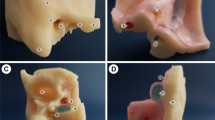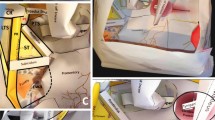Abstract
Purpose
Despite the combination of chalkboard lectures and cadaveric models, the ear remains a complex anatomical structure that is difficult for medical students to grasp. The aim of this study was to evaluate the contribution of a 3D-printed ear model for educating undergraduate medical students by comparing it with a conventional cadaveric model.
Methods
Models of the ear comprising the outer ear, tympanic membrane, ossicles and inner ear were modeled and then 3D-printed at 6:1 and 10:1 scales based on cadaveric dissection and CT, cone-beam CT and micro/nano CT scans. Cadaveric models included two partially dissected dry temporal bones and ossicles. Twenty-four 3rd year medical students were given separate access to cadaveric models (n = 12) or 3D-printed models (n = 12). A pre-test and two post-tests were carried out to assess knowledge (n = 24). A satisfaction questionnaire focusing solely on the 3D-printed model, comprising 17 items assessed on a 5-point Likert scale, was completed by all study participants. A 5-point Likert scale questionnaire comprising four items (realism, color, quality and satisfaction with the 3D-printed ear model) was given to three expert anatomy Professors.
Results
The test scores on the first post-test were higher for the students who had used the 3D-printed models (p < 0.05). Overall satisfaction among the students and the experts was very high, averaging 4.7 on a 5-point Likert-type satisfaction scale.
Conclusion
This study highlights the overall pedagogical value of a 3D-printed model for learning ear anatomy.













Similar content being viewed by others
Data availability
Not applicable.
References
Abou-Elhamd KEA, Al-Sultan AI, Rashad UM (2010) Simulation in ENT medical education. J Laryngol Otol 124(3):237–241. https://doi.org/10.1017/S0022215109991885
Anschuetz L, Huwendiek S, Stricker D, Yacoub A, Wimmer W, Caversaccio M (2019) Assessment of middle ear anatomy teaching Methodologies using microscopy versus endoscopy: a randomized comparative study. Anat Sci Educ 12(5):507–517. https://doi.org/10.1002/ase.1837
Backhouse S, Taylor D, Armitage JA (2019) Is this mine to keep? Three-dimensional printing enables active, personalized learning in anatomy. Anat Sci Educ 12(5):518–528. https://doi.org/10.1002/ase.1840
Bannon R, Parihar S, Skarparis Y, Varsou O, Cezayirli E (2018) 3D printing the pterygopalatine fossa: a negative space model of a complex structure. Surg Radiol Anat 40(2):185–191. https://doi.org/10.1007/s00276-017-1916-x
Brumpt E, Bertin E, Tatu L, Louvrier A (2023) 3D printing as a pedagogical tool for teaching normal human anatomy: a systematic review. BMC Med Educ 23(1):783. https://doi.org/10.1186/s12909-023-04744-w
Chae R, Sharon JD, Kournoutas I et al (2020) Replicating skull base anatomy with 3D technologies: a comparative study using 3D-scanned and 3D-printed models of the temporal bone. Otol Neurotol 41(3):e392–e403. https://doi.org/10.1097/MAO.0000000000002524
Chen S, Pan Z, Wu Y et al (2017) The role of three-dimensional printed models of skull in anatomy education: a randomized controlled trail. Sci Rep 7(1):575. https://doi.org/10.1038/s41598-017-00647-1
Chen Y, Qian C, Shen R et al (2020) 3D printing technology improves medical interns’ understanding of anatomy of gastrocolic trunk. J Surg Educ 77(5):1279–1284. https://doi.org/10.1016/j.jsurg.2020.02.031
Chytas D, Salmas M, Demesticha T, Troupis T (2023) Three-dimensional printing in anatomy education: is it similarly useful for teaching of all anatomical regions and structures? Anat Sci Educ 16(1):5–6. https://doi.org/10.1002/ase.2216
Dauber W (2007) Lexique illustré d’anatomie FENEIS. Médecine- Sciences Flammarion, Paris
Fieux M, Zaouche S, Philouze P, Truy E, Hermann R, Tringali S (2021) Low-fidelity otoscopy simulation and anatomy training: a randomized controlled trial. Eur Ann Otorhinolaryngol Head Neck Dis 138(4):231–234. https://doi.org/10.1016/j.anorl.2020.09.010
Frithioff A, Frendø M, Weiss K et al (2023) 3-D-printed models for temporal bone training: a validity study. Otol Neurotol 44(7):e497–e503. https://doi.org/10.1097/MAO.0000000000003936
Garas M, Vaccarezza M, Newland G, McVay-Doornbusch K, Hasani J (2018) 3D-printed specimens as a valuable tool in anatomy education: a pilot study. Ann Anat Anat Anz 219:57–64. https://doi.org/10.1016/j.aanat.2018.05.006
Gnanasegaram JJ, Leung R, Beyea JA (2020) Evaluating the effectiveness of learning ear anatomy using holographic models. J Otolaryngol Head Neck Surg 49(1):63. https://doi.org/10.1186/s40463-020-00458-x
Guy J, Muzaffar J, Coulson C (2021) Teaching middle ear anatomy using a novel three-dimensional papercraft model. Eur Arch Oto-Rhino-Laryngol 278(8):2769–2774. https://doi.org/10.1007/s00405-020-06350-8
Hochman JB, Rhodes C, Wong D, Kraut J, Pisa J, Unger B (2015) Comparison of cadaveric and isomorphic three-dimensional printed models in temporal bone education. Laryngoscope 125(10):2353–2357. https://doi.org/10.1002/lary.24919
Javan R, Herrin D, Tangestanipoor A (2016) Understanding spatially complex segmental and branch anatomy using 3D printing. Acad Radiol 23(9):1183–1189. https://doi.org/10.1016/j.acra.2016.04.010
Javan R, Rao A, Jeun BS, Herur-Raman A, Singh N, Heidari P (2020) From ct to 3D printed models, serious gaming, and virtual reality: framework for educational 3D visualization of complex anatomical spaces from within—the pterygopalatine fossa. J Digit Imaging 33(3):776–791. https://doi.org/10.1007/s10278-019-00315-y
Krishnasamy S, Mokhtar RAR, Singh R, Sivallingam S, Aziz YFA, Mathaneswaran V (2021) 3D rapid prototyping heart model validation for teaching and training—a pilot project in a teaching institution. Braz J Cardiovasc Surg. https://doi.org/10.21470/1678-9741-2020-0433
Lee DJ, Fu TS, Carrillo B, Campisi P, Forte V, Chiodo A (2015) Evaluation of an otoscopy simulator to teach otoscopy and normative anatomy to first year medical students: simulation-based otoscopy training. Laryngoscope 125(9):2159–2162. https://doi.org/10.1002/lary.25135
Mogali SR, Chandrasekaran R, Radzi S et al (2022) investigating the effectiveness of three-dimensionally printed anatomical models compared with plastinated human specimens in learning cardiac and neck anatomy: a randomized crossover study. Anat Sci Educ 15(6):1007–1017. https://doi.org/10.1002/ase.2128
Mukherjee P, Cheng K, Chung J, Grieve SM, Solomon M, Wallace G (2021) Precision medicine in ossiculoplasty. Otol Neurotol 42(2):e177–e185. https://doi.org/10.1097/MAO.0000000000002928
Ng CL, Liu X, Chee SCJ, Ngo RYS (2015) An Innovative 3-dimensional model of the epitympanum for teaching of middle ear anatomy. Otolaryngol Neck Surg 153(5):832–837. https://doi.org/10.1177/0194599815584600
Nguyen Y, Mamelle E, De Seta D, Sterkers O, Bernardeschi D, Torres R (2017) modifications to a 3D-printed temporal bone model for augmented stapes fixation surgery teaching. Eur Arch Otorhinolaryngol 274(7):2733–2739. https://doi.org/10.1007/s00405-017-4572-1
Nicholson DT, Chalk C, Funnell WRJ, Daniel SJ (2006) Can virtual reality improve anatomy education? A randomised controlled study of a computer-generated three-dimensional anatomical ear model. Med Educ 40(11):1081–1087. https://doi.org/10.1111/j.1365-2929.2006.02611.x
O’Brien C, Souza CA, Sheikh A, Miguel O, Wood T (2021) Use of tracheobronchial tree 3-dimensional printed model: does it improve trainees’ understanding of segmentation anatomy? A prospective study. Print Med 7(1):2. https://doi.org/10.1186/s41205-020-00092-3
Park HS, Chung MS, Shin DS, Jung YW, Park JS (2013) Accessible and informative sectioned images, color-coded images, and surface models of the ear: accessible and informative images of ear. Anat Rec 296(8):1180–1186. https://doi.org/10.1002/ar.22719
Radzi S, Tan HKJ, Tan GJS et al (2020) Development of a three-dimensional printed heart from computed tomography images of a plastinated specimen for learning anatomy. Anat Cell Biol 53(1):48–57. https://doi.org/10.5115/acb.19.153
Roth H, Smith RA, Mackay S (2013) Modern day relevance of William Hunter’s approach to teaching “The organ of hearing”: William Hunter and the organ of hearing. Clin Anat 26(5):551–555. https://doi.org/10.1002/ca.22220
Salazar D, Thompson M, Rosen A, Zuniga J (2022) Using 3D printing to improve student education of complex anatomy: a systematic review and meta-analysis. Med Sci Educ 32(5):1209–1218. https://doi.org/10.1007/s40670-022-01595-w
Saleh Y, Piper R, Richard M, Jeyaretna S, Cosker T (2022) Designing a 3D Printed model of the skull-base: a collaboration between clinicians and industry. J Med Educ Curric Dev 9:238212052210807. https://doi.org/10.1177/23821205221080703
Shelmerdine SC, Simcock IC, Hutchinson JC et al (2018) 3D printing from microfocus computed tomography (micro-CT) in human specimens: education and future implications. Br J Radiol. https://doi.org/10.1259/bjr.20180306
Shen Z, Yao Y, Xie Y et al (2019) The process of 3D printed skull models for anatomy education. Comput Assist Surg 24(sup1):121–130. https://doi.org/10.1080/24699322.2018.1560101
Stramiello JA, Wong SJ, Good R, Tor A, Ryan J, Carvalho D (2022) Validation of a three-dimensional printed pediatric middle ear model for endoscopic surgery training. Laryngoscope Investig Otolaryngol 7(6):2133–2138. https://doi.org/10.1002/lio2.945
Tan L, Wang Z, Jiang H et al (2022) Full color 3D printing of anatomical models. Clin Anat 35(5):598–608. https://doi.org/10.1002/ca.23875
Tanner JA, Jethwa B, Jackson J et al (2020) A three-dimensional print model of the pterygopalatine fossa significantly enhances the learning experience. Anat Sci Educ 13(5):568–580. https://doi.org/10.1002/ase.1942
Thompson AR, O’Loughlin VD (2015) The blooming anatomy tool (BAT): a discipline-specific rubric for utilizing bloom’s taxonomy in the design and evaluation of assessments in the anatomical sciences: blooming anatomy tool for evaluating MCQs. Anat Sci Educ 8(6):493–501. https://doi.org/10.1002/ase.1507
Ye Z, Dun A, Jiang H et al (2020) The role of 3D printed models in the teaching of human anatomy: a systematic review and meta-analysis. BMC Med Educ 20(1):335. https://doi.org/10.1186/s12909-020-02242-x
Ye Z, Jiang H, Bai S et al (2023) Meta-analyzing the efficacy of 3D printed models in anatomy education. Front bioeng biotechnol 11:1117555. https://doi.org/10.3389/fbioe.2023.1117555
Zhang X, Xu Z, Tan L et al (2019) Application of three-dimensional reconstruction and printing as an elective course for undergraduate medical students: an exploratory trial. Surg Radiol Anat 41(10):1193–1204. https://doi.org/10.1007/s00276-019-02248-1
Acknowledgements
The authors sincerely thank those who donated their bodies to science so that anatomical research could be performed. Results from such research can potentially increase mankind's overall knowledge that can then improve patient care. Therefore, these donors and their families deserve our highest gratitude.
Funding
None.
Author information
Authors and Affiliations
Contributions
All authors contributed to the study conception and design. Material preparation, data collection and analysis were performed by EB, AL, XG, CC and EB. The first draft of the manuscript was written by EB and all authors commented on previous versions of the manuscript. All authors read and approved the final manuscript.
Corresponding author
Ethics declarations
Competing interests
The authors declare no competing interests.
Conflict of interest
The authors declare that they have no conflict of interest.
Ethical approval
No ethical clearance was required as cadavers are used for research purpose.
Additional information
Publisher's Note
Springer Nature remains neutral with regard to jurisdictional claims in published maps and institutional affiliations.
Rights and permissions
Springer Nature or its licensor (e.g. a society or other partner) holds exclusive rights to this article under a publishing agreement with the author(s) or other rightsholder(s); author self-archiving of the accepted manuscript version of this article is solely governed by the terms of such publishing agreement and applicable law.
About this article
Cite this article
Brumpt, E., Bertin, E., Gabrion, X. et al. Are 3D-printed anatomical models of the ear effective for teaching anatomy? A comparative pilot study versus cadaveric models. Surg Radiol Anat 46, 103–115 (2024). https://doi.org/10.1007/s00276-023-03276-8
Received:
Accepted:
Published:
Issue Date:
DOI: https://doi.org/10.1007/s00276-023-03276-8




